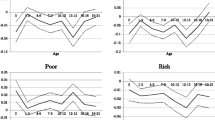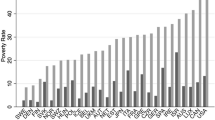Abstract
Previous research shows that living in a non-intact family is associated with educational disadvantages. This paper compares the relationships between childhood family structure, schooling, and earnings in Sweden and the USA. This comparison is interesting because both family structure and public policies differ significantly. We find a negative relationship between living in a non-intact family and child outcomes, and the estimates are remarkably similar in both countries. After using sibling-difference models, the correlation with family structure is no longer significant. These results cast doubt on the causal interpretation of the negative relationship between non-intact family structures and child outcomes.
Similar content being viewed by others
Notes
The sample sizes are somewhat smaller in the analysis of earnings in 1996 as fewer persons had positive earnings.
Wolfe, Haveman, Ginther, and An (1996) enumerate papers with the window problem.
In the US samples, to be considered a stepparent, an individual must be married to the biological parent of the child. The proportion of childhood in a given family structure in the NLSY is measured as the number of years in that family structure divided by 17. In most cases, an individual’s childhood (ages 1–16) is not entirely observed between 1968 and 1985 in the PSID sample. Thus, we define family structure as the number of years a child between the ages of 1 and 16 is observed in the sample in a given family structure divided by the total number of years the child is ages 1–16 between 1968 and 1985. The proportion of childhood in a given family structure in Sweden is measured as the number of bidecennial censuses observed in that family structure divided by 4 in the descriptive section below and in the cross-section estimations but divided by 3 for the FE-estimations, see Section 3.1.
In some cases, PSID observations have zero sampling weights in 1993 because of exit and reentry into the sample. For these observations, we assign the average sampling weight. In addition, the 1994 sampling weight may be missing because the number of years of schooling was observed in a previous year; we also assign the average sampling weight for these cases.
Both of these differences are significant at the 5% (or less) level of significance.
Note also that the standard argument that measurement-error bias is aggravated in sibling-difference models comes from research on the returns to schooling – where years of schooling is an independent variable – and does not apply to our study. In returns to schooling applications, the educational attainment of two siblings are measured independently in two interviews and any (independent) measurement error leads to a sibling difference in educational attainment that does not exist. In our data sets, family structure is, by construction, defined in the same way for two siblings who belong to the same family. This said, we do not rule out that some measurement-error bias plague the results from many sibling-difference analyses of family structure, and we recommend that future research effort be devoted to this somewhat neglected question.
Out of consideration of space, the results of these tests are not presented here but can be obtained from the authors upon request.
There are too few half siblings for a meaningful analysis.
References
Andersson G (2002) Children’s experience of family disruption and family formation: evidence from 16 FFS countries. Demographic research 7 (7). Available at http://www.demographic-research.org
Biblarz TJ, Raftery AE (1999) Family structure, educational attainment, and socioeconomic success: rethinking the ‘pathology of matriarchy’. Am J Sociol 105(2):321–365
Biblarz TJ, Gottainer G (2000) Family structure and children’s success: a comparison of widowed and divorced single-mother families. J Marriage Fam 62(2):533–548
Björklund A, Sundström M (2006) Parental separation and children’s educational attainment: a siblings approach. Economica (In press)
Case A, Lin I-F, McLanahan S (2001) Educational attainment of siblings in stepfamilies. Evol Hum Behav 22(4):269–289
Cherlin AJ, Furstenberg FF, Chase-Lansdale PL, Kiernan KE et al (1991) Longitudinal studies of effects of divorce on children in Great Britain and the United States. Science 252(5011):1386–1389
Ermisch JF, Francesconi M (2001) Family structure and children’s achievements. J Popul Econ 14(2):249–270
Evenhouse E, Reilly S (2004) A sibling study of stepchild well-being. J Hum Resour 39(1):248–276
Gennetian L (2005) One or two parents? Half or step siblings? The effect of family composition on young children’s achievement. J Popul Econ 18(3):415–436
Ginther DK, Pollak RA (2004) Family structure and children’s educational outcomes: blended families, stylized facts, and descriptive regressions. Demography 41(4):671–696
Gruber J (2004) Is making divorce easier bad for children? The long run implications of unilateral divorce. J Labor Econ 22(4):799–834
Jonsson JO, Gähler M (1997) Family dissolution, family reconstitution, and children’s educational careers: recent evidence from Sweden. Demography 34(2):277–293
Lang K, Zagorsky JL (2001) Does growing up with a parent absent really hurt? J Hum Resour 36(2):253–273
McLanahan S, Sandefur G (1994) Growing up with a single parent: what hurts, what helps. Harvard University Press, Cambridge
Manski C, Sandefur G, McLanahan S, Powers D (1992) Alternative estimates of the effect of family structure during adolescence on high school graduation. J Am Stat Assoc 87(417):25–37
Painter G, Levine DI (2000) Family structure and youths’ outcomes: which correlations are causal? J Hum Resour 35(3):524–549
Piketty T (2003) The impact of divorce on school performance. Evidence from France, 1968–2002. CEPR discussion paper 4146
Ribar DC (2004) What do social scientists know about the benefits of marriage? A review of quantitative methodologies. IZA discussion paper 998, IZA, Bonn
Winkelmann R (2006) Parental separation and well-being of youths. J Socio-econ 35(2):197–208
Acknowledgements
Ginther acknowledges financial support from the University of Kansas General Research Fund. Björklund and Sundström thank the Swedish Council for Working Life and Social Research for financial support. Ginther, Björklund, and Sundström acknowledge financial support from NICHD Grant R03HD048931 and thank the anonymous referees for their comments.
Author information
Authors and Affiliations
Corresponding author
Additional information
Responsible Editor: Deborah Cobb-Clark
Rights and permissions
About this article
Cite this article
Björklund, A., Ginther, D.K. & Sundström, M. Family structure and child outcomes in the USA and Sweden. J Popul Econ 20, 183–201 (2007). https://doi.org/10.1007/s00148-006-0094-7
Received:
Accepted:
Published:
Issue Date:
DOI: https://doi.org/10.1007/s00148-006-0094-7




